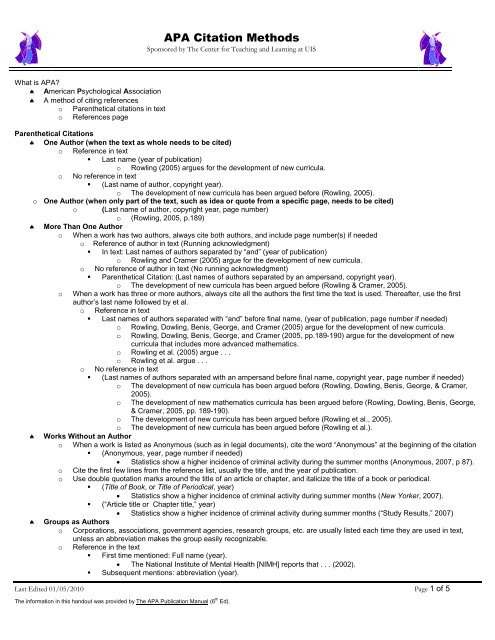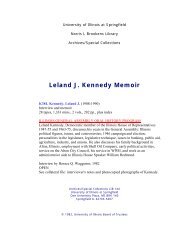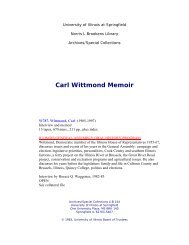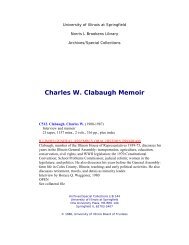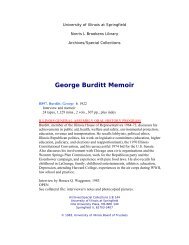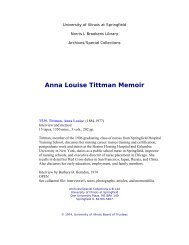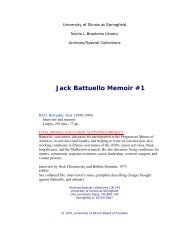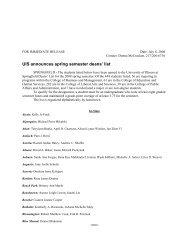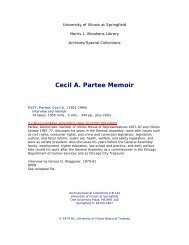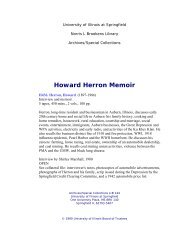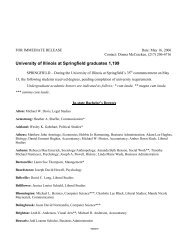APA Style
APA Style
APA Style
You also want an ePaper? Increase the reach of your titles
YUMPU automatically turns print PDFs into web optimized ePapers that Google loves.
<strong>APA</strong> Citation Methods<br />
Sponsored by The Center for Teaching and Learning at UIS<br />
What is <strong>APA</strong>?<br />
American Psychological Association<br />
A method of citing references<br />
o Parenthetical citations in text<br />
o References page<br />
Parenthetical Citations<br />
One Author (when the text as whole needs to be cited)<br />
o Reference in text<br />
• Last name (year of publication)<br />
o Rowling (2005) argues for the development of new curricula.<br />
o No reference in text<br />
• (Last name of author, copyright year).<br />
o The development of new curricula has been argued before (Rowling, 2005).<br />
o One Author (when only part of the text, such as idea or quote from a specific page, needs to be cited)<br />
o (Last name of author, copyright year, page number)<br />
o (Rowling, 2005, p.189)<br />
More Than One Author<br />
o When a work has two authors, always cite both authors, and include page number(s) if needed<br />
o Reference of author in text (Running acknowledgment)<br />
• In text: Last names of authors separated by “and” (year of publication)<br />
o Rowling and Cramer (2005) argue for the development of new curricula.<br />
o No reference of author in text (No running acknowledgment)<br />
• Parenthetical Citation: (Last names of authors separated by an ampersand, copyright year).<br />
o The development of new curricula has been argued before (Rowling & Cramer, 2005).<br />
o When a work has three or more authors, always cite all the authors the first time the text is used. Thereafter, use the first<br />
author’s last name followed by et al.<br />
o Reference in text<br />
• Last names of authors separated with “and” before final name, (year of publication, page number if needed)<br />
o Rowling, Dowling, Benis, George, and Cramer (2005) argue for the development of new curricula.<br />
o Rowling, Dowling, Benis, George, and Cramer (2005, pp.189-190) argue for the development of new<br />
curricula that includes more advanced mathematics.<br />
o Rowling et al. (2005) argue . . .<br />
o Rowling et al. argue . . .<br />
o No reference in text<br />
• (Last names of authors separated with an ampersand before final name, copyright year, page number if needed)<br />
o The development of new curricula has been argued before (Rowling, Dowling, Benis, George, & Cramer,<br />
2005).<br />
o The development of new mathematics curricula has been argued before (Rowling, Dowling, Benis, George,<br />
& Cramer, 2005, pp. 189-190).<br />
o The development of new curricula has been argued before (Rowling et al., 2005).<br />
o The development of new curricula has been argued before (Rowling et al.).<br />
Works Without an Author<br />
o When a work is listed as Anonymous (such as in legal documents), cite the word “Anonymous” at the beginning of the citation<br />
• (Anonymous, year, page number if needed)<br />
Statistics show a higher incidence of criminal activity during the summer months (Anonymous, 2007, p 87).<br />
o Cite the first few lines from the reference list, usually the title, and the year of publication.<br />
o Use double quotation marks around the title of an article or chapter, and italicize the title of a book or periodical.<br />
• (Title of Book, or Title of Periodical, year)<br />
Statistics show a higher incidence of criminal activity during summer months (New Yorker, 2007).<br />
• (“Article title or Chapter title,” year)<br />
Statistics show a higher incidence of criminal activity during summer months (“Study Results,” 2007)<br />
Groups as Authors<br />
o Corporations, associations, government agencies, research groups, etc. are usually listed each time they are used in text,<br />
unless an abbreviation makes the group easily recognizable.<br />
o Reference in the text<br />
• First time mentioned: Full name (year).<br />
The National Institute of Mental Health [NIMH] reports that . . . (2002).<br />
• Subsequent mentions: abbreviation (year).<br />
Last Edited 01/05/2010 Page 1 of 5<br />
The information in this handout was provided by The <strong>APA</strong> Publication Manual (6 th Ed).
<strong>APA</strong> Citation Methods<br />
Sponsored by The Center for Teaching and Learning at UIS<br />
The NIMH reports . . . (2002).<br />
o Not referenced in text<br />
• First time mentioned (full name, year)<br />
(National Institute of Mental Health, 2002).<br />
• Subsequent mentions (abbreviation, year)<br />
(NIMH, 2002).<br />
o If the name is not easily recognizable by an abbreviation, such as the University of Iowa, the group must be spelled out each<br />
time it is mentioned.<br />
Classical Works<br />
o When using classical works such as the Greeks, Romans, or the Bible, a reference entry is not required. You must only<br />
identify the version and lines used.<br />
• 1 Cor. 13:1 (Revised Standard Edition)<br />
o When using very old works where the date is not applicable, list the year of the translation you used.<br />
o Reference in text<br />
• Aristotle argues . . . (trans. 1922).<br />
o Not referenced in text<br />
• The ethos, pathos, and logos . . . (Aristotle, trans. 1922).<br />
o If a text does not have a date, cite the author’s name followed by “n.d.”<br />
o Reference in text (n.d.)<br />
• Julius Caesar argued . . . (n.d.).<br />
o Not referenced in text<br />
• The Trojan horse . . . (Caesar, n.d.)<br />
Reference List<br />
Used to indicate where information presented in the essay can be retrieved.<br />
Only include texts cited in the essay.<br />
Listed alphabetically by author or title.<br />
Reference list begins a new page, with “References” centered at top of page.<br />
The first line of an entry is at the left margin, and subsequent lines are indented ½” (hanging indent).<br />
Author’s Names<br />
o Use last names, first initials with all authors’ names in reverse order, regardless of quantity<br />
Last name, first initial.<br />
Mills, S.R., Griggs, B.W., & Holland, R.H.<br />
Capitalization of Titles<br />
o Capitalize the first word in the title and subtitle, and any proper nouns (cities, countries, peoples’ names) for book, article, and<br />
chapter titles<br />
o Capitalize the first word, all nouns, verbs, adverbs, and adjectives for names of journals<br />
o Use no special treatment for titles of shorter works (poems, short stories, essays, short articles)<br />
o Italicize titles of longer works (books, periodicals/journals)<br />
o Don’t drop any words, such as A, An, or The, from the titles of periodicals (newspapers, magazines, journals)<br />
Place of Publication<br />
o Give the city for US publishers and add the state abbreviations for all US cities except Baltimore, Boston, Chicago, Los<br />
Angeles, New York, Philadelphia, and San Francisco<br />
• City, State: Name of press<br />
Anderson, IN: Warner Press.<br />
o Use a shortened version of the publisher’s name except for an association (AMA), corporation, or university press; drop Co.,<br />
Inc., Publishers, but retain Books or Press<br />
• City, State: Name of press<br />
Anderson, IN: Warner Press.<br />
Books<br />
o Three main parts: Author, title, and publication information<br />
o Book with one author<br />
• Last name, first initial. (year). Title. City of Publication: Press.<br />
Broadway, B. (2002). Pink houses and family taverns. Bloomington, IL: Indiana University Press.<br />
o Two to seven authors<br />
• Last name, first initial., Last Name, first initial., & Last Name, first initial.. (year). Title. City of publication: Press.<br />
Broadway, B., & Carrol, L., Smith, T. (2007). How the lady sings. New York: Harper.<br />
o Eight or more authors<br />
• List first six authors as (Last Name, first initial.), then an ellipsis followed by the last author’s name.<br />
Last Edited 01/05/2010 Page 2 of 5<br />
The information in this handout was provided by The <strong>APA</strong> Publication Manual (6 th Ed).
<strong>APA</strong> Citation Methods<br />
Sponsored by The Center for Teaching and Learning at UIS<br />
<br />
<br />
<br />
• Last name, first initial., Last Name, first initial., Last Name, first initial., Last Name, first initial., Last Name, first initial.,<br />
Last Name, first initial., . . . Last Name, first initial. (year). Title. City of publication: Press.<br />
o Arrange references by the same author chronologically, with the earlier date of publication listed first<br />
• Van Delay, A. (1994). Venetian blinds: Contemporary study of compulsive lying. New York: Pendant Publishing.<br />
• Van Delay, A. (1997). Seinfeld: The show about nothing. New York: Penguin Books.<br />
o No Author<br />
• Title (year). City of publication: press.<br />
Creation of the media: Political origins of the media. (1922). Los Angeles: Houghton-Mifflin.<br />
The Chicago manual of style (15th ed.) (2003). Chicago: University of Chicago Press.<br />
Journal Articles<br />
o Four major parts: author, date, article title, and publication information (periodical title, volume number [in italics], and page<br />
number)<br />
• Last name, first initial. (year). Title of article. Title of publication, volume, pages.<br />
Tyson, P.A., & Gordon, M.G. (1998). The Psychology of women. Journal of the American Psychoanalytic<br />
Association, 46, 361-364.<br />
Bernstein, B.J. Atomic diplomacy: Hiroshima and Nagasaki. Diplomatic History, 28 (3), 126-129.<br />
• Eight or more authors<br />
Last name, first initial., Last Name, first initial., Last Name, first initial., Last Name, first initial., Last Name,<br />
first initial., Last Name, first initial.,… Last Name, first initial. (year). Title. Publication Title, Volume, pages.<br />
Gilbert, D. G., McClernon, J. F., Rabinovich, N. E., Sugai, C., Plath, L. C., Asgaard, G., … Botros, N. (2004).<br />
Effects of quitting smoking on EEG activation and attention last for more than 31 days and are more severe<br />
with stress, dependence, DRD2 A1 allele, and depressive traits. Nicotine and Tobacco Research, 6, 249-<br />
267.<br />
Newspaper and Magazine Articles<br />
o<br />
o<br />
Five major parts: author, date of publication, title of article, title of newspaper or magazine, page numbers.<br />
For magazines, the volume and issue number are inserted after the magazine title, formatted: Volume(Issue).<br />
• Last name, first initial. (year, month day of publication). Title of article. Title of newspaper or magazine, page<br />
numbers.<br />
Kramer, C.F. (2003, June 22). A health threat baffling for its lack of a pattern. The New York Times, p. A14.<br />
Chamberlin, J., Novotney, A., Packard, E., & Price, M. (2008, May). Enhancing worker well-being:<br />
Occupational health psychologists convene to share their research on work, stress, and health. Monitor on<br />
Psychology. 39(5), 26-29.<br />
Don’t abbreviate the names of months, ever.<br />
o<br />
Electronic Sources<br />
o<br />
o<br />
o<br />
Article accessed through a library subscription service<br />
• Seven major parts: author’s name, year of publication, title of article and publication, volume number, issue number,<br />
page numbers, and where retrieved.<br />
<br />
Last name, first initial. (year). Title of article. Title of publication, volume(issue), page numbers. Retrieved<br />
from where.<br />
o Jackson, G. (2004). Multiple historic meanings of the Spanish civil war. Science and Society, 68(3),<br />
272-276. Retrieved from the Lexis Nexis Academic database.<br />
Online daily newspaper<br />
• Six major parts: author’s name, date of publication, title of article and publication, and web address.<br />
Last name, first initial. (year, month day of publication). Title of article. Title of publication. Retrieved from<br />
web address.<br />
o Foreman, R., Bennett, E., & Collins, T. (1999, February 16). In forecasting their emotions, most<br />
people flunk out. The New York Times. Retrieved from http://www.nytimes.com.<br />
Personal or Professional Websites<br />
• Four major parts: website name/author of website (if known), Retrieved web address.<br />
Last name, first initial. Page of site. Retrieved from web address.<br />
o Colbert, S. Home page. Retrieved from http://www.colbertnation.com.<br />
• Title of website. (last updated date). Retrieved web address.<br />
American Association for Artificial Intelligence. (2001, March). Retrieved from http://www.aaai.org.<br />
o<br />
DOI’s<br />
Last Edited 01/05/2010 Page 3 of 5<br />
The information in this handout was provided by The <strong>APA</strong> Publication Manual (6 th Ed).
<strong>APA</strong> Citation Methods<br />
Sponsored by The Center for Teaching and Learning at UIS<br />
• A DOI is a unique alphanumeric string assigned to identify content and provide a persistent link to its location<br />
on the Internet.<br />
• The DOI may be hidden; viewing the original copy of the article usually shows the DOI.<br />
• Use this format for the DOI in references: doi:xxxxxxxxx<br />
• When a DOI is used, no further retrieval information is needed to identify or locate the content.<br />
• If no DOI has been assigned to the content, provide the home page URL of the journal or of the book or report<br />
publisher. No retrieval date is needed.<br />
• The DOI is made up of two components, a prefix and a suffix, separated by a forward slash.<br />
Here’s the DOI, on<br />
the first page of<br />
the article.<br />
• Journal Article with DOI<br />
<br />
Herbst-Damm, K. L., & Kulik, J. A. (2005). Volunteer support, marital status, and the survival times of<br />
terminally ill patients. Health Psychology, 24, 225-229. doi: 10.1037/0278-6133.24.2.225<br />
• Journal Article with DOI, more than eight authors<br />
Gilbert, D. G., McClernon, J. F., Rabinovich, N. E., Sugai, C., Plath, L. C., Asgaard, G., . . . Botros, N.<br />
(2004). Effects of quitting smoking on EEG activation and attention last for more than 31 days and are<br />
more severe with stress, dependence, DRD2 A1 allele, and depressive traits. Nicotine and Tobacco<br />
Research, 6, 249-267. doi: 10.1080/14622200410001676305<br />
• Journal Article without DOI<br />
<br />
Sillick, T. J., & Schutte, N. S. (2006). Emotional intelligence and self-esteem mediate between<br />
perceived early parental love and adult happiness. E-Journal of Applied Psychology, 2(2), 38-48.<br />
Retrieved from http://ojs.lib.swin.edu.au/index.php/ejap<br />
Last Edited 01/05/2010 Page 4 of 5<br />
The information in this handout was provided by The <strong>APA</strong> Publication Manual (6 th Ed).
<strong>APA</strong> Citation Methods<br />
Sponsored by The Center for Teaching and Learning at UIS<br />
Sample Reference Page<br />
References<br />
American Association for Artificial Intelligence. (2001, March). Retrieved from http://www.aaai.org.<br />
Bernstein, B. J. (2003). Atomic diplomacy: Hiroshima and Nagasaki. Diplomatic History, 28(3), 126-129.<br />
Broadway, B. (2002). Pink houses and family taverns. Bloomington, IL: Indiana University Press.<br />
Broadway, B., Carrol, L., Smith, T. (2007). How the lady sings. New York: Harper.<br />
Broadway, B., et al. (2008). How the man sings. New York: Harper.<br />
Chamberlin, J., Novotney, A., Packard, E., & Price, M. (2008, May). Enhancing worker well-being: Occupational health psychologists<br />
convene to share their research on work, stress, and health. Monitor on Psychology. 39(5), 26-29.<br />
Crane, N. F. (2003, September). Anarchy at sea. Atlantic Monthly, 50-80.<br />
Creation of the media: Political origins of the media. (1922). Los Angeles: Houghton-Mifflin.<br />
Foreman, R., Bennett, E., & Collins, T. (1999, February 16). In forecasting their emotions, most people flunk out. The New York Times.<br />
Retrieved from http://www.nytimes.com.<br />
Gilbert, D. G., McClernon, J. F., Rabinovich, N. E., Sugai, C., Plath, L. C., Asgaard, G., . . . Botros, N. (2004). Effects of quitting smoking<br />
on EEG activation and attention last for more than 31 days and are more severe with stress, dependence, DRD2 A1 allele, and<br />
depressive traits. Nicotine and Tobacco Research, 6, 249-267. doi: 10.1080/14622200410001676305<br />
Herbst-Damm, K. L., & Kulik, J. A. (2005). Volunteer support, marital status, and the survival times of terminally ill patients. Health<br />
Psychology, 24, 225-229. doi: 10.1037/0278-6133.24.2.225<br />
Jackson, G. (2004). Multiple historic meanings of the Spanish civil war. Science and Society, 68(3), 272-276. Retrieved from the Lexis<br />
Nexis Academic database.<br />
Kramer, C. F. (2003, June 22). A health threat baffling for its lack of a pattern. The New York Times, p. A14.<br />
Peterman, J. S. (2005, March 28). Eat this now! US News and World Report, 56-58.<br />
Sillick, T. J., & Schutte, N. S. (2006). Emotional intelligence and self-esteem mediate between perceived early parental love and adult<br />
happiness. E-Journal of Applied Psychology, 2(2), 38-48. Retrieved from http://ojs.lib.swin.edu.au/index.php/ejap<br />
Tyson, P. A., & Gordon, M. G. (1998). The psychology of women. Journal of the American Psychoanalytic Association, 46, 361-364.<br />
Van Delay, A. (1994). Venetian blinds: Contemporary study of compulsive lying. New York: Pendant Publishing.<br />
Van Delay, A. (1997). Seinfeld: The show about nothing. New York: Penguin Books.<br />
Last Edited 01/05/2010 Page 5 of 5<br />
The information in this handout was provided by The <strong>APA</strong> Publication Manual (6 th Ed).


